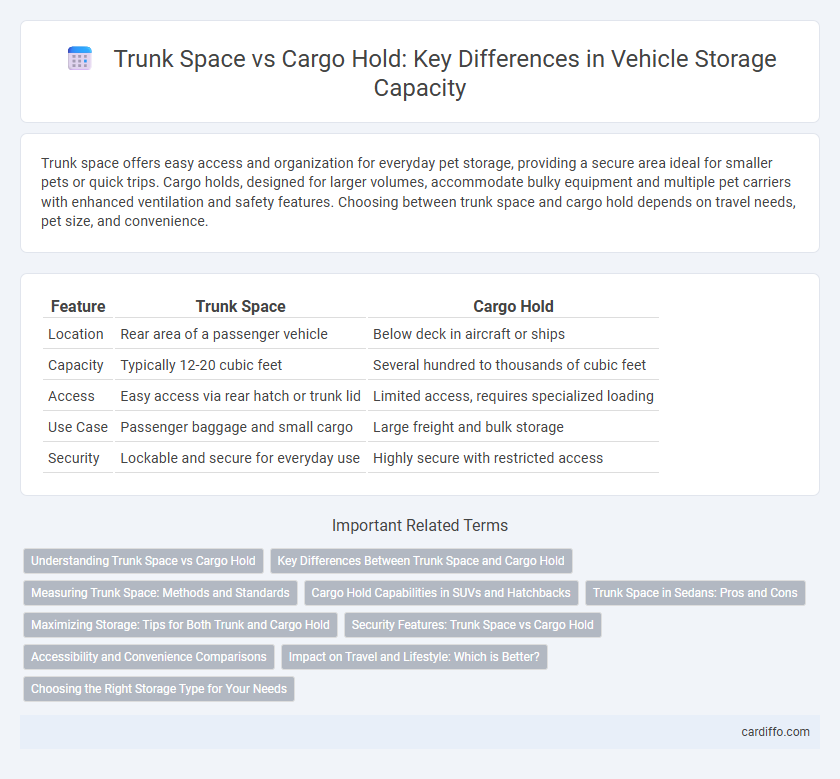Trunk space offers easy access and organization for everyday pet storage, providing a secure area ideal for smaller pets or quick trips. Cargo holds, designed for larger volumes, accommodate bulky equipment and multiple pet carriers with enhanced ventilation and safety features. Choosing between trunk space and cargo hold depends on travel needs, pet size, and convenience.
Table of Comparison
| Feature | Trunk Space | Cargo Hold |
|---|---|---|
| Location | Rear area of a passenger vehicle | Below deck in aircraft or ships |
| Capacity | Typically 12-20 cubic feet | Several hundred to thousands of cubic feet |
| Access | Easy access via rear hatch or trunk lid | Limited access, requires specialized loading |
| Use Case | Passenger baggage and small cargo | Large freight and bulk storage |
| Security | Lockable and secure for everyday use | Highly secure with restricted access |
Understanding Trunk Space vs Cargo Hold
Trunk space refers to the enclosed storage area at the rear of most passenger vehicles, designed for everyday items and small to medium luggage. Cargo hold typically describes the larger, more versatile storage compartment found in trucks, SUVs, or aircraft, capable of accommodating bulkier goods and equipment. Understanding the differences in size, accessibility, and intended use helps optimize storage solutions based on vehicle type and cargo needs.
Key Differences Between Trunk Space and Cargo Hold
Trunk space refers to the enclosed storage area typically found at the rear of a car, designed for everyday items and smaller luggage, whereas cargo hold is the larger, often more flexible storage compartment in aircraft or large vehicles suited for bulkier goods. Trunk space dimensions are limited by vehicle design and usually offer organized compartments, while cargo holds prioritize volume and weight capacity to accommodate freight and oversized items. Understanding these differences is essential for selecting appropriate storage solutions based on size, accessibility, and intended use.
Measuring Trunk Space: Methods and Standards
Measuring trunk space involves precise methods such as volume displacement, where water or beads fill the compartment to calculate capacity in liters or cubic feet. Industry standards like SAE J1100 define test procedures ensuring consistent trunk space measurements across vehicle models. Accurate measurement of trunk space helps consumers evaluate cargo capacity effectively compared to cargo hold volumes found in other transport forms.
Cargo Hold Capabilities in SUVs and Hatchbacks
Cargo hold capabilities in SUVs and hatchbacks vary significantly, with SUVs typically offering larger and more versatile storage areas due to their higher rooflines and adjustable rear seats, allowing for enhanced load capacity and easier transportation of bulkier items. Hatchbacks, while more compact, maximize cargo space efficiency through fold-down rear seats, creating a flat loading area suitable for everyday storage needs and smaller cargo. The design differences impact overall trunk space usability, with SUVs excelling in volume and flexibility, while hatchbacks prioritize accessibility and urban practicality.
Trunk Space in Sedans: Pros and Cons
Trunk space in sedans offers a secure, enclosed area that protects belongings from weather and theft, making it ideal for day-to-day storage needs. Its typically lower height and smaller opening can limit the size and shape of items that fit, reducing flexibility compared to an open cargo hold. Sedans also benefit from a separate trunk compartment, which maintains passenger privacy and interior cleanliness by isolating stored items.
Maximizing Storage: Tips for Both Trunk and Cargo Hold
Maximizing storage in both trunk space and cargo hold requires strategic organization and efficient use of available volume. Utilize stackable containers and vacuum bags to compress bulky items, freeing up more room for essentials. Prioritize weight distribution by placing heavier items at the bottom and securing loose objects to prevent shifting during transit.
Security Features: Trunk Space vs Cargo Hold
Trunk space in vehicles often includes built-in security features such as lockable compartments and reinforced steel panels to prevent unauthorized access, providing enhanced protection for personal belongings. Cargo holds, typically found in larger transport vehicles or aircraft, are equipped with advanced locking mechanisms, surveillance systems, and sometimes climate control to ensure the safety and integrity of stored goods during transit. Understanding these security distinctions helps in selecting the appropriate storage option based on the level of protection required for valuable or sensitive items.
Accessibility and Convenience Comparisons
Trunk space offers easier accessibility with a lower loading height and wider opening, making it convenient for daily use and quick loading of smaller items. Cargo holds provide more versatile storage options with deeper compartments, ideal for larger or irregularly shaped items but may require bending or reaching. Accessibility in trunks generally supports frequent, lighter use, while cargo holds excel in accommodating bulkier loads with secure placement.
Impact on Travel and Lifestyle: Which is Better?
Trunk space offers easy access and organization for daily commuting and short trips, enhancing convenience and quick loading. Cargo holds provide significantly more volume for bulky or numerous items, making them ideal for long-distance travel and outdoor lifestyles. Selecting between trunk space and cargo hold depends on travel frequency, load size, and lifestyle needs, impacting comfort and efficiency on the road.
Choosing the Right Storage Type for Your Needs
Trunk space offers convenient, easily accessible storage ideal for daily use and smaller loads, while cargo holds provide larger, more secure storage suited for extended trips or transporting bulky items. Evaluating your specific storage needs, including the volume, frequency of access, and security requirements, helps determine whether a trunk or cargo hold optimally supports your lifestyle or travel plans. Prioritizing the appropriate storage type enhances efficiency and protects your belongings during transit.
trunk space vs cargo hold Infographic

 cardiffo.com
cardiffo.com